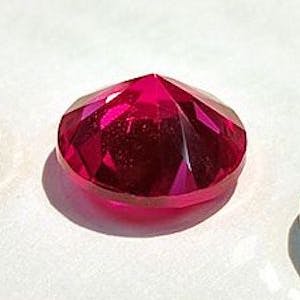Can You Make Money Cutting Synthetic Gemstones?
Selling lab-created cut gems can be quite difficult. Learn what makes this market hard to crack and the best ways to make money cutting synthetic gemstones.
3 Minute Read
Why Price is King for Synthetic Gemstones
Let's assume, of course, that you're a competent faceter before trying to make money selling cut stones. Otherwise, you're wasting your time trying to make money, no matter what you're cutting. Nevertheless, making money by cutting synthetic gemstones is quite difficult, because, almost always, price is king in the synthetic market.
Almost all synthetic gem materials are inexpensive and readily available, whether cut or rough. Of course, exceptions exist, such as Chatham emeralds, rubies and sapphires by some manufacturers, and synthetic alexandrite. However, even the manufacturers of these more expensive products must compete with alternative and cheaper but similar materials.
The lack of rarity among synthetic gemstones plays a major role in this market. Lab-produced gem materials of almost all types are easily available almost everywhere. Thus, rarity only factors into the synthetic market through custom cutting. However, most buyers of synthetic stones won't pay the difference for quality faceting.
Of course, cheap labor also greatly affects the price of synthetic gems. Commercial cutting houses can cut millions of carats of synthetic material every month, in all shapes and sizes.
A Lack of Rarity Reduces Profit Potential
How does this affect the bottom line of an independent faceter cutting synthetic gemstones? Most significantly, all this cheap competition means you'll have trouble making a profit selling your faceted synthetic stones. That is, if you can sell them at all. Basically, you can't make any money on the rough. Since the cost of rough is insignificant and it's available everywhere, there is no rarity. Everybody can and will compete with you, including the hobbyists who don't care about their time and just want to make a few dollars.
The lack of rarity in synthetic material lowers potential earnings dramatically while increasing competition. In contrast, when cutting natural gemstones, any rarity may improve salability and profits, sometimes substantially.
If you're cutting synthetic gemstones, all you can really charge for is your labor. Of course, if you have customers willing to pay for that, that's OK. The trick lies in finding those customers.
How to Compete in the Synthetic Gemstone Market
Having made the difficulties clear, again I say markets exist for almost any kind of faceted gemstone. In fact, a sizable market for synthetic gems does exist. So, how does a custom gem cutter make any money doing this?
First, a caveat. Yes, you can make money cutting synthetic gemstones. However, you won't make a living. In no way do I recommend attempting that. You'll face virtually unbeatable odds.
Quality Cutting
Promote the quality of your faceting. Cut quality is always a selling point. With synthetic materials, this is one of the few advantages a custom cutter has over commercial cutting. Show your customers how quality cutting makes a difference in a gem's optical performance.
Unique Designs
Cut gem designs with obvious differences, designs the customer has never seen. In other words, don't cut the designs commercial cutters use. This is another area where custom cutters have an edge, providing a finished product commercial suppliers can't.
Less Common Synthetic Materials
Most synthetic rough is inexpensive and easily available. However, some materials are more expensive and harder to find cut. Working with Chatham emerald, synthetic alexandrite, and materials like yttrium aluminum garnet (YAG) could help you make money.
Avoid cutting cubic zirconia (CZ). Consumers can find it commercially cut almost anywhere, in any size and shape. For commercial houses, it costs just pennies to facet. For you, it will cost much more.
The Replacement Stone Market
People often want replacement gems for their jewelry for many reasons. I think this market presents the best opportunity to make money cutting synthetic gemstones. Keep in mind that replacement doesn't only mean literally replacing lost stones. You could find yourself cutting a high-quality lab-created emerald to replace a natural, low-quality "junk" emerald. Or, you may be cutting a five-carat pigeon's blood synthetic ruby for someone who could never afford a natural gem of that quality and size.
Conclusion
You can make money cutting synthetic gemstones. You can also make money digging ditches. Personally, I prefer easier paths to financial gain. That's also why I recommend novices practice faceting with natural instead of synthetic quartz. At least you might sell what you eventually cut.
Cut something worth your time. The synthetic market is tough to crack. Even if you make some money, you'll be making "labor only" hourly wages while competing with very cheap labor.
Optimistically, you might occasionally make money selling faceted synthetics with quality cuts or as replacement stones. Just choose your designs and rough wisely.
Jeff R. Graham
The late Jeff Graham was a prolific faceter, creator of many original faceting designs, and the author of several highly-regarded instructional faceting books such as Gram Faceting Designs.
Related Articles
Should Beginners Practice Faceting on Natural or Synthetic Quartz?
Out Back Mining Company
Tucson Gem Show Dates 2006
How to Identify Synthetic Rough in Gemstone Parcels
Latest Articles
Precision Faceting a Story Gemstone: Choosing Rough
32 Green Gemstones (How Many Do You Know?)
A Guide to Antique Georgian Jewelry
Hambergite Value, Price, and Jewelry Information
Never Stop Learning
When you join the IGS community, you get trusted diamond & gemstone information when you need it.
Get Gemology Insights
Get started with the International Gem Society’s free guide to gemstone identification. Join our weekly newsletter & get a free copy of the Gem ID Checklist!
